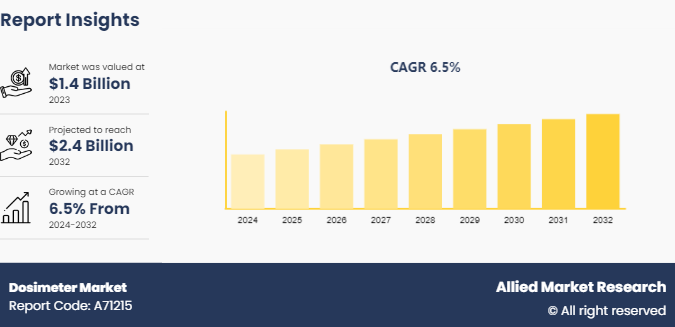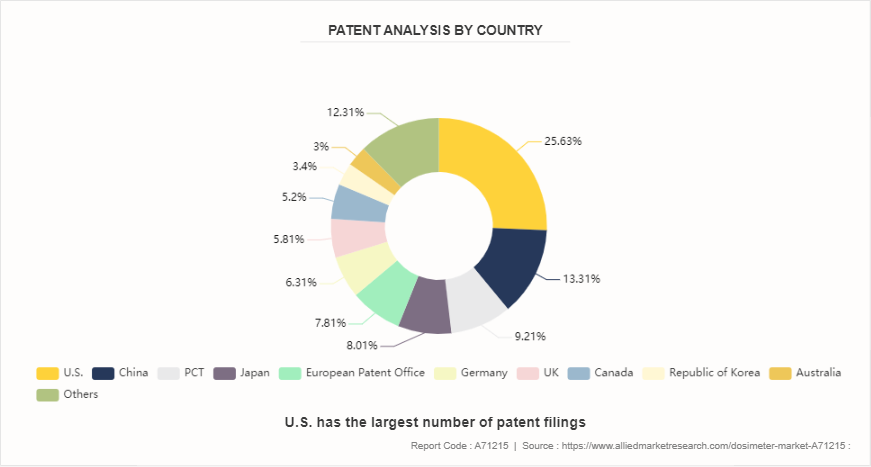Dosimeter Market Research, 2032
The Global Dosimeter Market was valued at $1.4 billion in 2023 and is projected to reach $2.4 billion by 2032, growing at a CAGR of 6.5% from 2024 to 2032.
A dosimeter is a device that measures an individual's exposure to ionizing radiation and ensures that safety limits are not exceeded. These devices are crucial in radiation-prone locations such as medical facilities, nuclear power plants, and research laboratories. Dosimeters are available in a variety of formats, including thermoluminescent dosimeters (TLDs) , electronic personal dosimeters (EPDs), and film badge dosimeters. They work by sensing and measuring the quantity of radiation absorbed over time, offering real-time or cumulative results. This information is critical for monitoring and protecting workers' health and safety, ensuring regulatory compliance, and reducing the risk of radiation-related illnesses. Advances in dosimeter technology have increased accuracy, ease of use, and the ability to store and analyze data digitally, further enhancing their effectiveness in radiation management and protection.

Key Takeaways
- Based on type, the multi-phase segment dominated the dosimeter market in terms of revenue in 2023 and is anticipated to grow at a high CAGR during the forecast period.
- Based on the application, the converter segment dominated the dosimeter market size in terms of revenue in 2023 and is anticipated to grow at the fastest CAGR during the forecast period.
- By end-use industry, the market is dominated by the electronics and electrical segment in the year 2023 and is expected to dominate the dosimeter market forecasted period.
- Region-wise, Asia-Pacific generated the largest revenue in 2023 and is anticipated to grow at the highest CAGR during the forecast period.
Industry Trends:
- On May 8, 2023, the Nuclear Regulatory Commission (NRC) implemented stricter regulations for radiation exposure monitoring in healthcare, nuclear power plants, and industrial settings. The new regulations mandate the use of advanced dosimeters with real-time monitoring capabilities, automatic data logging, and remote dose management. This move is expected to drive the demand for technologically advanced dosimeter solutions with enhanced safety and data management features.
- On May 19, 2023, the European Commission allocated €30 million in funding for research projects focused on developing new dosimeter technologies for environmental radiation monitoring. These projects will investigate novel sensor materials, miniaturization techniques, and data analysis algorithms to create more sensitive, portable, and affordable dosimeters for detecting low-level radiation in various environments, including soil, water, and air.
- On June 4, 2023, the Health and Safety Executive (HSE) launched a national campaign to raise awareness about radiation safety in the workplace. The campaign emphasizes the importance of regular dosimeter usage and encourages employers to provide adequate training and resources for radiation protection. This initiative is expected to boost the demand for personal dosimeters in industries with potential radiation exposure risks.
- On June 15, 2023, the Atomic Energy Regulatory Board (AERB) implemented new guidelines for radiation protection in medical imaging and radiotherapy. These guidelines mandate the use of dosimeters for patients and medical staff, promoting safer radiation practices and potentially increasing the demand for dosimeters in the healthcare sector.
Key Market Dynamics
The dosimeter industry is rapidly expanding as a result of changing market dynamics and trends. One of the primary reasons is the growing demand for consumer electronics, which are now being used in sectors with potential radiation exposure, such as medical imaging and industrial applications. Furthermore, the use of dosimeters in the automobile industry has increased, particularly with the introduction of self-driving vehicles, which require advanced radiation detecting systems for safety reasons. The demand for dosimeters is also being driven by advancements in communications infrastructure, particularly 5G networks, which are already being deployed and require denser population areas to be shielded from any potential radiation consequences. Moreover, the rise of renewable energy sources – wind parks or solar farms necessitate using Dosimeters to ensure workers constructing and maintaining these facilities are working safely.
However, the high initial costs associated with cutting-edge dosimeter technology may prevent their widespread adoption by small and medium-sized firms. These advancements exhibit the importance of dosimeters in terms of security and regulatory compliance, consequently driving growth and innovation in the relevant areas.
Patent Analysis of the Global Dosimeter Market
The global dosimeter sector analysis is segmented according to the patents filed in the U.S., China, PCT, Japan, European Patent Office, Germany, the UK, Canada, the Republic of Korea, and Australia. The dosimeter for U.S. market has the largest number of patent filings, owing to suitable research infrastructure. Approvals from these authorities are followed/accepted by registration authorities in many of the developing regions/countries. Therefore, this region has the maximum number of patent filings. This applicant was followed by the U.S Market, which registered over 1821 from 2015 to 2024.

Market Segmentation
The dosimeter industry report is segmented into type, application, end-use industry, and region. Based on the type, the market is divided into electronic personal dosimeters, thermoluminescent dosimeters, film badge dosimeters, and optically stimulated luminescence (OSL) dosimeters. By application, the dosimeter market is bifurcated into active and passive. By end-use industry, the dosimeter market insights are analyzed across healthcare, oil and gas, mining, manufacturing, and others. Region-wise, the dosimeter market data is analyzed across North America, Europe, Asia-Pacific, Latin America, and the Middle East & Africa.
Regional/Country Market Outlook
Region-wise, Asia-Pacific generated the largest revenue in 2023, owing to its robust industrial base, rapid technological advancements, and increasing awareness of radiation safety. The presence of a large number of nuclear power plants and the expansion of healthcare infrastructure in countries like China, India, and Japan drive the demand for radiation monitoring devices. Additionally, the rapid industrialization and urbanization in the region contribute to increased radiation exposure risks, necessitating stringent safety measures and the adoption of dosimeters. Moreover, government regulations and safety standards in Asia-Pacific are becoming more rigorous, further propelling the demand for radiation monitoring solutions. The continuous technological advancements and the increasing focus on occupational health and safety in the region underscore the dominance of Asia-Pacific in the dosimeter market.
Competitive Landscape
Dosimeter Company list includes Landauer, Thermo Fisher Scientific, Mirion Technologies, Ludlum Measurements, Canberra, Unfors RaySafe, IBA Dosimetry, Biodex Medical Systems, Tracerco, and Arrow-Tech. Other dosimeter market shares by companies are analyzed across players in the dosimeter market, including Players PTW, Panasonic, and so on.
Recent Key Strategies and Developments
- On February 05, 2024, Landauer, a leading provider of radiation safety solutions, launched the myLDR (my Landauer Dose Record) app, empowering individuals to monitor their radiation exposure in real time. The app allows users to view their personalized dose reports, track cumulative exposure over time, and receive alerts if dose limits are exceeded. This innovative tool provides greater transparency and control over personal radiation safety, particularly for professionals working in healthcare, nuclear power, and industrial environments.
- On May 01, 2024: Thermo Fisher Scientific, a global leader in scientific research and diagnostics, introduced the RadEye GF10, a next-generation gamma radiation detector. The RadEye GF10 boasts improved sensitivity and response time compared to previous models, enabling faster and more accurate detection of gamma radiation sources. This device is designed for use in various applications, including nuclear power plants, environmental monitoring, and emergency response scenarios.
- On June 17, 2024, Mirion Technologies, a leading provider of radiation detection and measurement solutions, announced the acquisition of the Dosimetry Services Division of Radiation Detection Company. This strategic move strengthens Mirion's position in the dosimetry market, expanding its capabilities and service offerings for customers in healthcare, nuclear power, and other industries where radiation monitoring is critical.
Key Sources Referred
- Semiconductor Industry Association (SIA)
- SEMI.org
- IEEE Electron Devices Society (EDS)
- U.S. Department of Energy
- Global Semiconductor Alliance (GSA)
- World Economic Forum
- European Semiconductor Industry Association (ESIA)
Key Benefits For Stakeholders
- This report provides a quantitative analysis of the market segments, current trends, estimations, and dynamics of the dosimeter market analysis from 2024 to 2032 to identify the prevailing dosimeter market opportunities.
- The market research is offered along with information related to key drivers, restraints, and opportunities.
- Porter's five forces analysis highlights the potency of buyers and suppliers to enable stakeholders make profit-oriented business decisions and strengthen their supplier-buyer network.
- In-depth analysis of the dosimeter market segmentation assists to determine the prevailing market opportunities.
- Dosimeter market size by country in each region are mapped according to their revenue contribution to the global market.
- Market player positioning facilitates benchmarking and provides a clear understanding of the present position of the market players.
- The report includes the analysis of the regional as well as global dosimeter market trends, key players, dosimeter market share by companies, market segments, dosimeter market value, radiation measurement, radiation dosage, occupational safety, application areas, dosimeter growth drivers, and dosimeter market growth strategies.
Dosimeter Market Report Highlights
| Aspects | Details |
| Market Size By 2032 | USD 2.4 Billion |
| Growth Rate | CAGR of 6.5% |
| Forecast period | 2024 - 2032 |
| Report Pages | 270 |
| By End Use Industry |
|
| By Region |
|
| By Type |
|
| By Application |
|
| Key Market Players | IBA Dosimetry, Arrow-Tech, Thermo Fisher Scientific Inc., Biodex Medical Systems, Landauer, Ludlum Measurements, Unfors RaySafe, Canberra, Mirion Technologies, Tracerco |
The dosimeter market was valued at $1.4 million in 2023 and is estimated to reach $2.4 million by 2032, exhibiting a CAGR of 6.5% from 2024 to 2032.
By end-use industry, the dosimeter market insights are analyzed across healthcare, oil and gas, mining, manufacturing, and others Region-wise, Asia-Pacific generated the largest revenue in 2023 owing to its robust industrial base, rapid technological advancements, and increasing awareness of radiation safety. The presence of a large number of nuclear power plants and the expansion of healthcare infrastructure in countries like China, India, and Japan drive the demand for radiation monitoring dev
By application, active segment dominated the market in 2023 due to its capability to provide real-time radiation exposure monitoring, offering immediate feedback and alerts. This feature is crucial in environments where radiation levels can change rapidly, such as in healthcare settings, nuclear facilities, and emergency response scenarios
The global dosimeter market is trending towards increased adoption of digital dosimeters, driven by advancements in radiation detection technology and growing awareness of occupational safety. Demand is rising in healthcare, nuclear power, and industrial sectors. Integration with IoT and data analytics for real-time monitoring and improved accuracy is also gaining traction.
The dosimeter market share by companies is analyzed across Landauer, Thermo Fisher Scientific, Mirion Technologies, Ludlum Measurements, Canberra, Unfors RaySafe, IBA Dosimetry, Biodex Medical Systems, Tracerco, and Arrow-Tech. Other dosimeter market shares by companies are analyzed across players in the dosimeter market including Players PTW, Panasonic, and so on
Loading Table Of Content...



